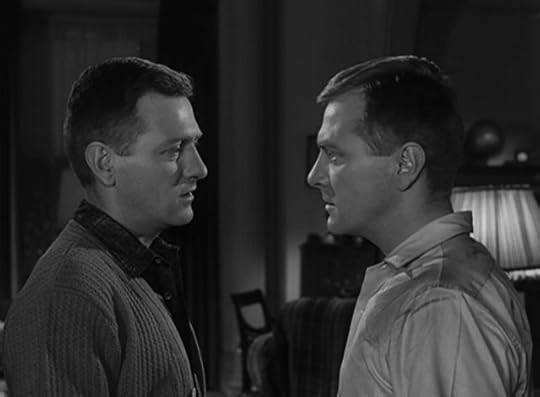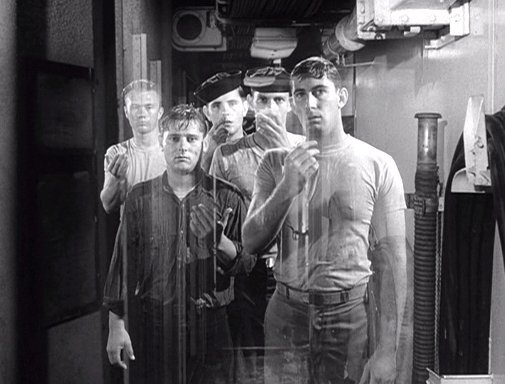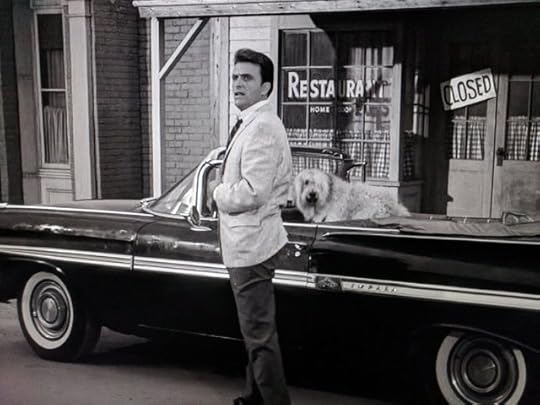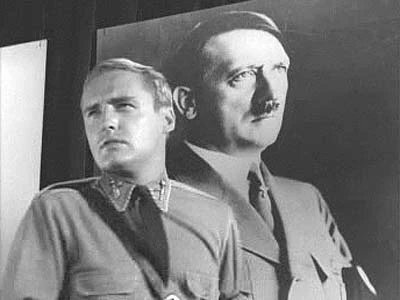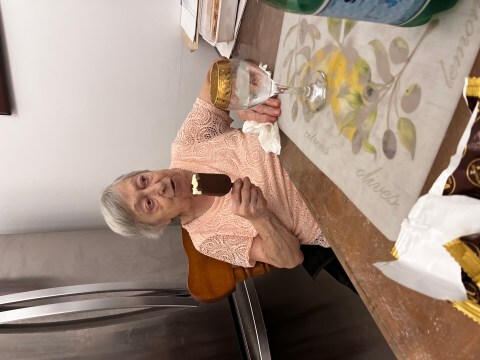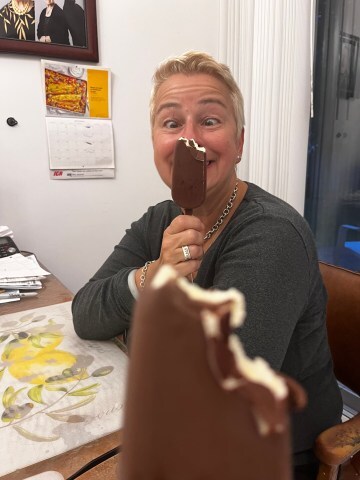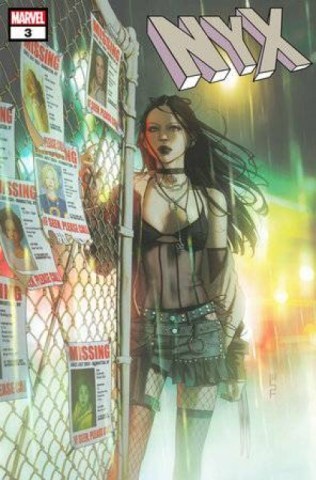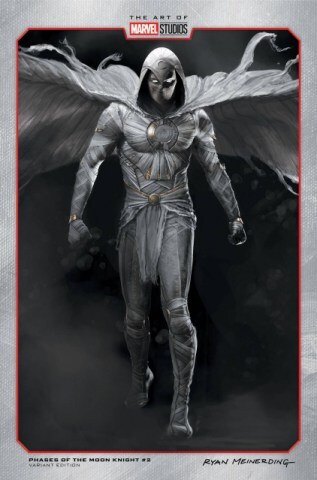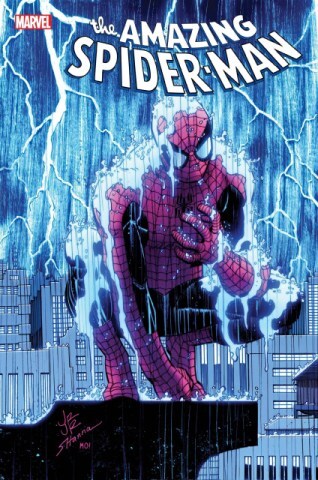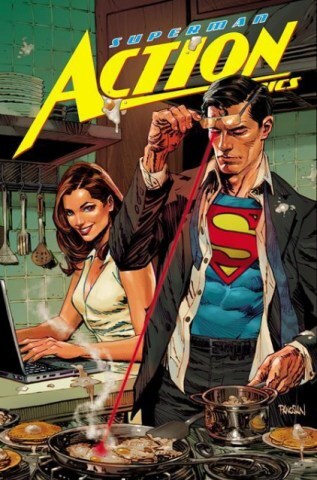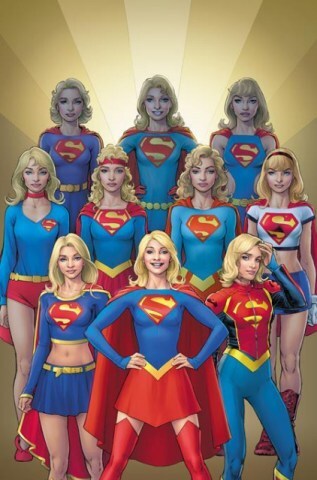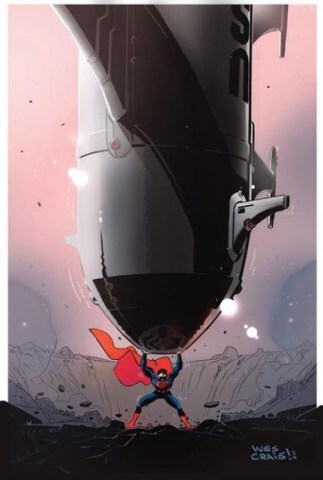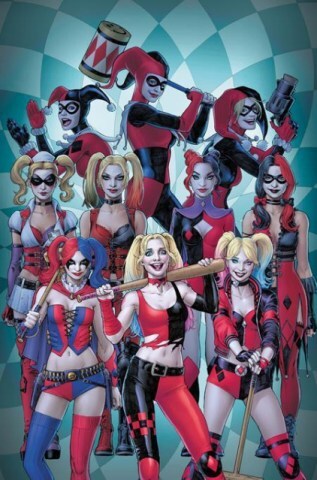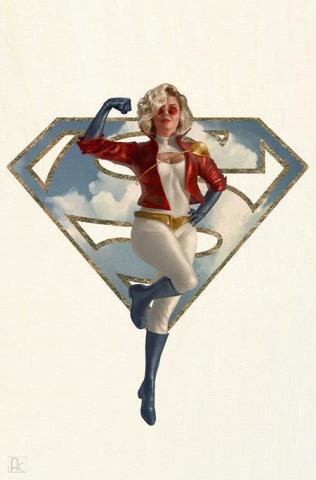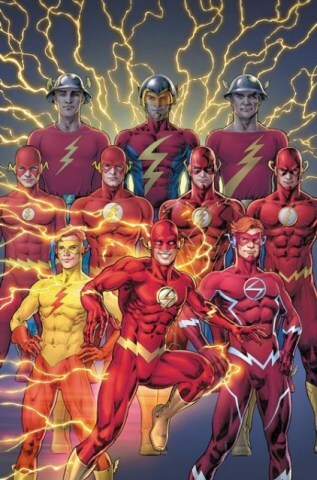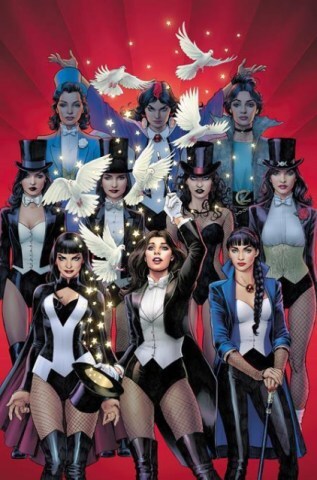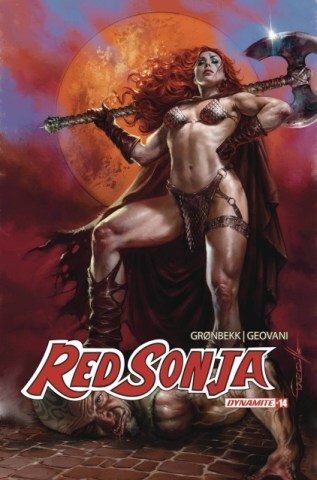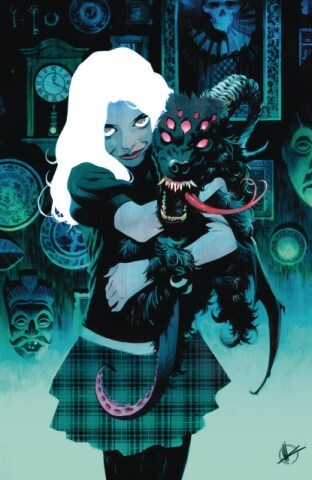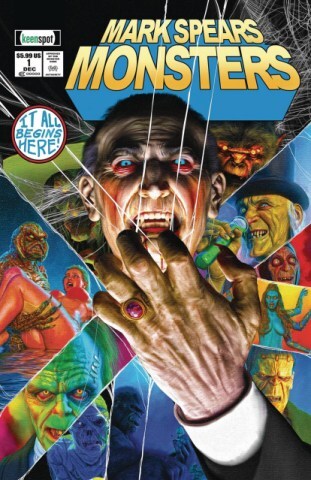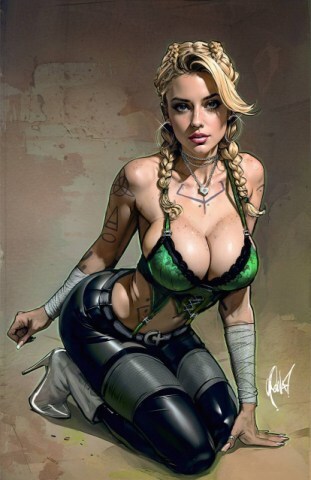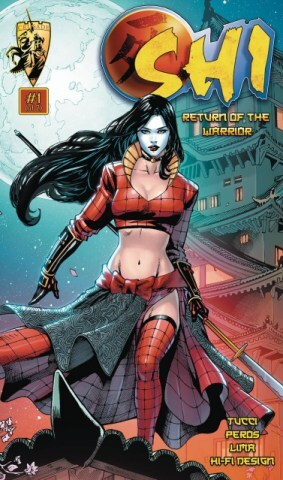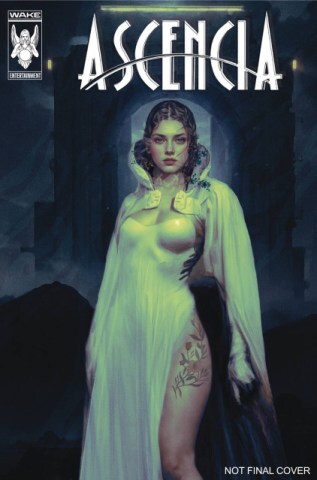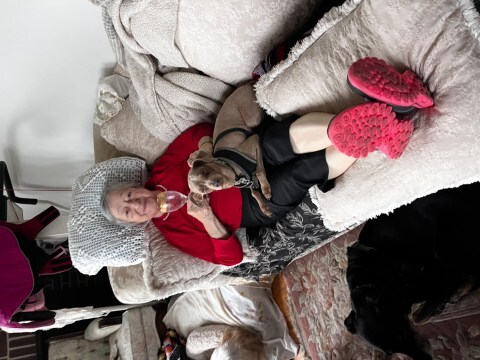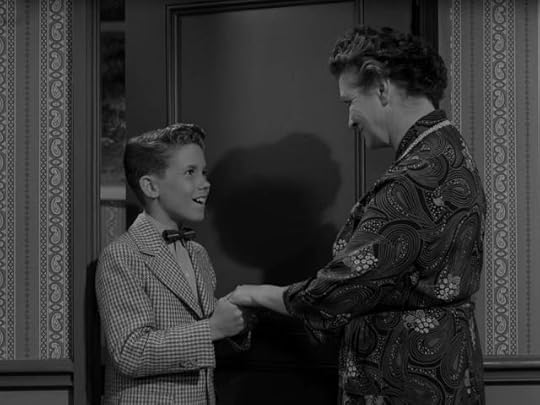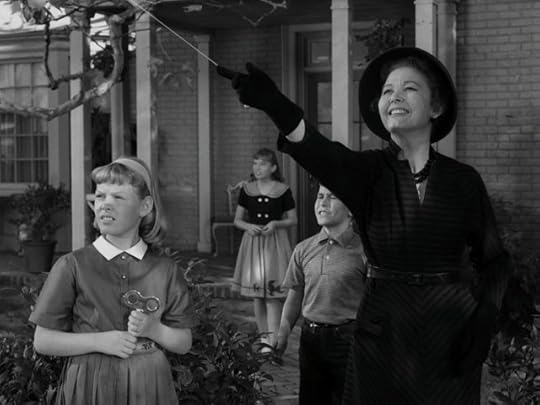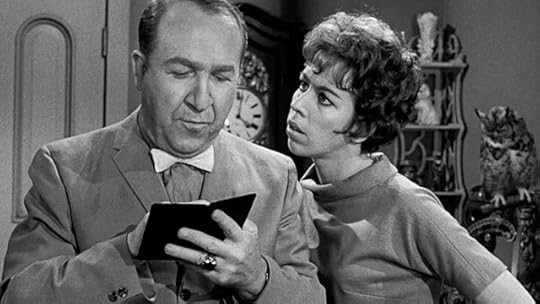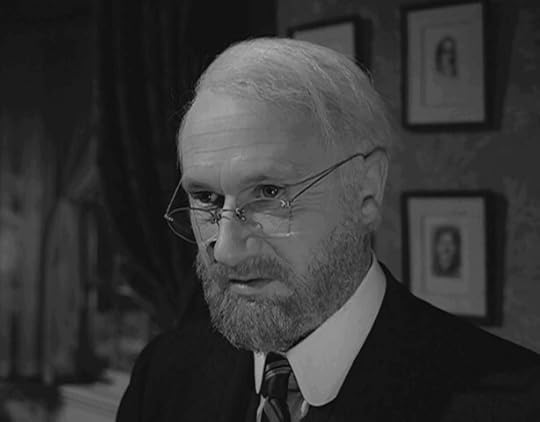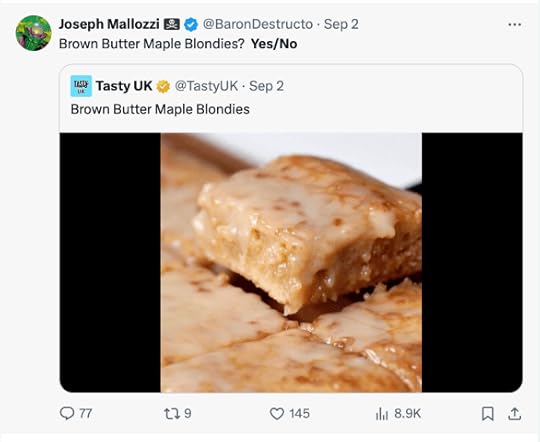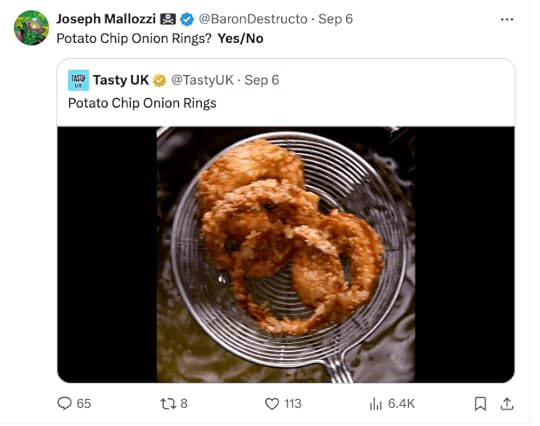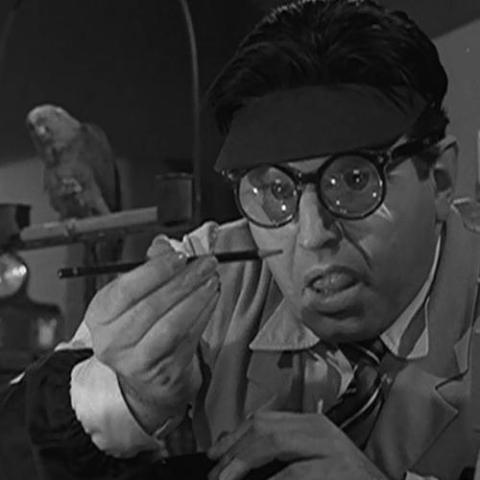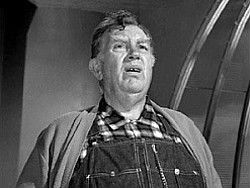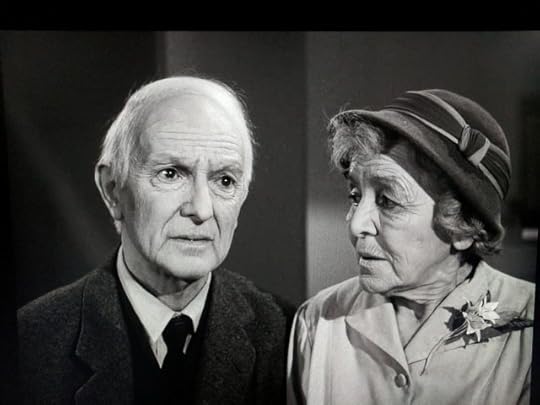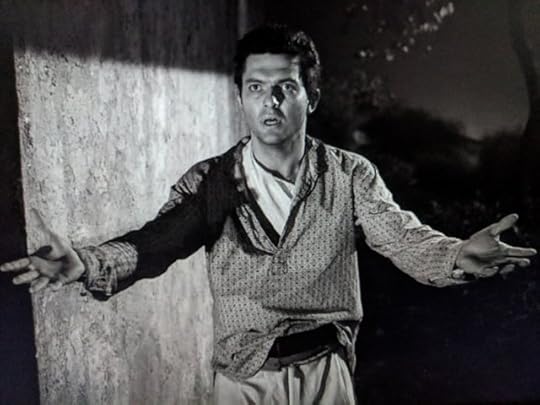Joseph Mallozzi's Blog, page 41
September 28, 2024
September 28, 2024: The Twilight Zone rewatch continues with season 4, episodes 1-4!
Season 4, Episode 1, “In His Image”
This episode was first broadcast January 3, 1963.
This episode was based on Charles Beaumont’s short story, “The Man Who Made Himself”. Apparently, Rod Serling had sought to purchase the rights to the short story for the first season but had been unable to do so at the time. Later, after “The Lateness of the Hour” aired, many of Beaumont’s friends contacted him wondering why he hadn’t been credited on the episode given its similarities to his short story.
There’s a certain sad irony in the fact that this episode deals with a man who begins to question his memories and, only months after it aired, writer Charles Beaumont began to exhibit signs of the early onset alzheimers that would claim his life.
The fourth season saw the episodes expand to a one hour format. Longtime TZ producer Buck Houghton’s vehement objection to the change resulted in his parting ways with the production.
This was the first episode to feature the memorable opening sequence featuring the door, a window breaking, and the flying doll.
The device on the wall in the robot lab was also used as part of the Krell machine in Forbidden Planet (1956).
Actor George Grizzzard, who played Alan Talbot, previously portrayed Roger Schackleforth in “The Chaser”.
Gail Kobe, who played Jessica Connelly, appeared as Sally the secretary in “A World of Difference”. Reflecting back on her Twilight Zone experience: “Rod Serling was around quite a lot for that – he was such a gentleman. He wasn’t very tall and my daddy wasn’t very tall either, so I had this love for men who were Rod Serling size.”
Katherine Squire, who played the Old Woman, previously appeared as the teacher, Mrs. Langsford, in “One More Pallbearer”.
George Petrie, who played the Driver, was Eddie Haskell’s father on Leave it to Beaver. His 14 guest appearances on The Honeymooners was second only to the main cast members.
Although I expect later episodes will stretch their respective premises pretty thin, this episode doesn’t really suffer from the extra runtime. It’s a pretty compelling mystery provided you can ignore some of the logic issues. Perry Lafferty, who would direct the first three episodes of the show’s fourth season, does a pretty good job here and makes me cautiously optimistic for future episodes.
Season 4, Episode 2, “The Thirty-Fathom Grave”
This episode was first broadcast January 10, 1963.
This episode was written before the network decided to transition to the one hour format. As a result, Serling ended up having to add several new scenes and, on the whole, the episode feels somewhat padded.
When sending the first batch of scripts for network approval, Serling included the following note: “I ask only that you keep in mind that story material for Twilight Zone is very much “camera” writing. That which may read as a slow and static movement, gains considerable momentum in its shooting.” Hmmmmmm.
Many point out similarities between the plot of “The Thirty-Fathom Grave” and the 1962 horror film “Carnival Of Souls” in which the survivor of a car crash is haunted by the undead until she ends up back to where she avoided death in the first place, her corpse recovered at the sight of the original car crash. Despite the similarities, it’s unlikely Serling could have been inspired by the movie, or vice-versa. Chalk this one up to coincidence.
In the initial draft, the skeletal remains of the sub’s crew are revealed but it was decided this would be distasteful so the reveal was lost in a subsequent rewrite.
Also in the original ending, Bell turns out to have been ghost all along. The network bumped on this.
The exterior shots of the ship in this episode were of the The “Mighty Mux” USS MULLINNIX DD-944, A Forrest Sherman class destroyer. The interior shots were on board the USS-Edson DD946.
Episode co-stars Mike Kellin and Simon Oakland died three days apart.
Among the crew members in this episode is a young Bill Bixby who gained fame, first as a co-star on My Favorite Martian (1963), then playing widowed father Tom Corbett on The Courtship of Eddie’s Father (1969), and finally as Dr. Bruce Banner on The Incredible Hulk (1977). Bixby was an accomplished director, magician, and dated Yvonne Craig, aka Batgirl from the 1966 Batman series.
I liked the set-up and didn’t mind the slow burn at first but, halfway through, it did begin to feel a little repetitive. I also think the reveal of the long dead crew man clutching a hammer would have served this episode well. Showing is always infinitely more interesting than telling.
Overall, I didn’t hate it – BUT I suspect I’m going to be hardpressed to come up with 10 favorite episodes. Maybe a Top 5?
Season 4, Episode 3, “Valley of the Shadows”
This episode was first broadcast January 17, 1963.
The original title of this episode was “Peaceful Valley”.
Actor Ed Nelson, who played Philiip Renfield, starred in many low-budget Roger Corman movies including Attack of the Crab Monsters (1957) in which he played a giant crab. He and actresss Barbara Perkins were the only cast members to appear in the very first and very last episodes of Peyton Place (1964-1969).
Natalie Trundy, who played Helen Marshall, had a promising career cut short by a serious back injury she suffered after being struck by a car. She made somewhat of a comeback, appearing in four moves in the Planet of the Apes series, but was never able to recapture her lost momentum. She married five times and spent her final years volunteering at Mother Theresa’s hospice in Kolkata, India.
James Doohan makes a small appearance in this episode. Better known as Star Trek’s Montgomery Scott, aka Scotty, Doohan voiced 53 different characters for the Star Trek Animated Series (1973).
Young Suzanne Caputo, who would later change her name to Morgan Brittany, made a previous Twilight Zone appearance as a little girl in season 1’s “Nightmares as a Child”. Reflecting back on this episode, she recalled: “Ed Neslon was great. A lot of actors back then dismisssed children or didn’t have a rapport with kids, but Ed was different. I remember we were doing the thing with the cat, and he came over and sat on the porch with me – he was a really nice guy. I don’t remember his dog’s name, but I do remember that its trainer was giving him so many treats that he didn’t want to work anymore.”
Overall, a pretty good episode although I did find it odd how fairly backwards this town was despite its access to advanced technology. I also found the Ellen Marshall character taking less than 24 hours to fall in love unintentionally funny – but I guess indicative of how many writers wrote female characters back in the day. My favorite charater was Rollie the dog who displayed incredible range here, from playful to angry, dead to alive. Maybe a Season 4 Top 5 entry?
Season 4, Episode 4, “He’s Alive”
This episode was first broadcast January 24, 1963.
Rod Serling apparently considered this episode “the most important” episode of the series.
Actor Dennis Hopper, who played Peter Vollmer, befriended James Dean on the set of Rebel Without a Cause (1955) and was grief-stricken by the young actor’s death. He considered Dean the finest actor he ever worked with.
Hopper appeared in mostly westerns until his breakout hit Easy Rider (1969) which he starred in and co-wrote with Peter Fonda and author Terry Southern. Some of his most memorable performances included his work on Apocalypse Now (1979), Out of the Blue (1980), True Romance (1993), and Speed (1994). He was apparently offered the role of Mr. Pink in Reservoir Dogs (1992), but was unable to commit so the part went to Steve Buscemi.
Director Paul Mazursky appears as Frank in this episode.
This episode is a great example of a writer becoming so intoxicated with the importance of his message that he casts aside subtlety in favor of bludgeoning the viewer with his lesson. Yes, yes, nazis are bad. What else ya got? The fact that this neo-nazi has developed a mutual friendship with a Jewish survivor of WWII is propsterous and borderline offensive. Meanwhile the “surprise” reveal of Hitler is absolutely ludicrous. As another reviewer pointed out, he looked like some schlub dressing up as Hitler up for a costume party. Also, that German accent was pretty atrocious. At the begining, it sounded vaguely Spanish! Overall, kind of embarrassing.
The post September 28, 2024: The Twilight Zone rewatch continues with season 4, episodes 1-4! appeared first on Joseph Mallozzi's Weblog.
September 27, 2024
Septem ber 27, 2024: The Montreal Wrap-Up!
Back to Toronto – for the time being.
Desserting
Kona
Ralphie
Sis’s tomato tart – and cannoli.
It’s more than likely I’ll be making a return trip sooner than later as we try to figure out next steps for mom.
P.S. Thanks for all your suggestions and personal accounts. They’ve been incredibly helpful!
The post Septem ber 27, 2024: The Montreal Wrap-Up! appeared first on Joseph Mallozzi's Weblog.
September 26, 2024
September 26, 2024: Preparing Hardboiled Eggs 101!
I received 112 comments to this post. Which led me to refine their suggestions into this helpful post:
From all the responses, I gather this is the best method for cooking a hardboiled egg. A little more work but worth it…
1) Bring eggs into the shower with you, showering at the hottest temperature you can stand, making sure to keep the eggs under the stream at all all times. After an hour…
2) Bring a pot of water to a boil, then turn off the heat and immerse the eggs, 1 teaspoon of vinegar, 1 teaspoon of salt, and a rusty nail. Let sit until the eggs reach room temperature.
3) Insert the whole egg into your mouth (you may require the assistance of family members if you plan on eating more than one). Once the egg has reached body temperature (8-10 minutes to be sure) they will be much easier to peel.
4) Peel and enjoy.
5) Don’t throw away the egg shells! They make a great textural filler to my aunt’s half-the-sugar cookies. Recipe to follow.
The post September 26, 2024: Preparing Hardboiled Eggs 101! appeared first on Joseph Mallozzi's Weblog.
September 25, 2024
September 25, 2024: Amazing Covers!
A few that caught my eye this week…
Nyx #3 – cover art by W. Scott Forbes
Phases of the Moon Kngiht #2 – cover art by Ryan Meinerding
The Amazing Spider-Man #58 – cover art by John Romita Jr.
Action Comics #1069 – cover art by Dan Panosian
Action Comics #1069 – cover art by Nicola Scott
Action Comics #1069 – cover art by Wesley Craig
Harley Quinn #43 – cover art by Nicola Scott
Power Girl #13 – cover art by Ariel Colon
The Flash #13 – cover art by Nicola Scott
Zatanna: Bring Down the House #4 – cover art by Nicola Scott
Red Sonja #14 – cover art by Lucio Parrillo
Hello Darkness #3 – cover art by Matteo Scalera, Giovanna Niro
Monsters #1 – cover art by Mark Spears
Grimm Fairy Tales #88 – cover art by Cedric Poulat
Shi: Return of the Warrior #1 – cover art by Bill Tucci
Ascensia #26 – cover art by Yorgos Cotronis
So, which were YOUR favorites?
The post September 25, 2024: Amazing Covers! appeared first on Joseph Mallozzi's Weblog.
September 24, 2024
September 24, 2024: In Montreal!
I’m in Montreal for the week to give my sister a much-needed break. In addition to her full-time job, she’s been taking care of my mother whose back issues have worsened. The pain is apparently so great that she can barely move and, when she does move, it’s a struggle. Things got so bad that she was in the hospital for a week as the doctors attempted to figure out he rpain management. I flew in on Monday fully expecting to spend 11-hour-days at the hospital – so Akemi packed me two bento boxes large enough to feed a family of four for days. BUT, the day before my arrival, my mother chose to discharge herself. In retrospect, perhaps not the right call since the pain management has still to be worked out.
Back home, I have a standing desk and do most of my writing – hell, even all of my zoom calls – standing. We take Sharky out for four walks and we hit the gym every night where I hit the treadmill for an hour. Obviously no standing desk here and, given my mother’s situation, I can’t really even go out for a walk. So I’ve been doing a lot of sitting since I got into town. Also, my diet has been…somewhat lacking. Back home, I do a lot of kefir. Akemi always pushes 2-3 veggies on me at lunch. And dinner is usually a couple of free-range eggs and some yogurt with fruit, all before 6:00 p.m. Here it’s late lunches and late big dinners. I dread weighing myself when I get back home.
Well, here’s hoping mom sees some improvement as she adjusts to her latest medley of meds.
The post September 24, 2024: In Montreal! appeared first on Joseph Mallozzi's Weblog.
September 23, 2024
September 23, 2024: My Twilight Zone Season 3 Top 10 Episodes!
In reverse order, of course, because that’s the way it’s done.
10) The Passerby
I actually had an easy Top 9 and then four potential episodes for the #10 spot. So honorable mentions inclue Two, Nothing in the Dark, and The Shelter.
9) Kick the Can
Solid, but I feel it’s a better idea for an episode than it is an actual finished episode.
8) A Game of Pool
I was surprised by how much I liked this one, but you can chalk it up to fantastic performances by Jack Klugman and Jonathan Winters.
7) The Changing of the Guard
Surprisingly heartfelt.
6) Showdown with Rance McGrew
This one had to be the most surprising entry here as I was fully expecting to hate it and ended up being hugely entertained by what is probably the best of the show’s humorous episodes.
5) The Midnight Sun
This one’s a classic. The thermometer exploding is a classic over-the-top TZ visual and the reverse twist at the end is a true chef’s kiss.
4) It’s a Good Life
Kids are creepy, and this episode confirms it.
3) Five Characters in Search of an Exit
13-year-old me with his massive action figure collection absolutely loved this episode. It has aged well. As has my massive action figure collection.
2) The Dummy
The ending to this one creeped the hell out of me when I saw it for the first time. That final reveal is, arguably, one of the scariest moments in Twilight Zone history.
1) To Serve Man
An all-around classic. Absolutely love the shot of the alien smiling appreciably as the heavy-set guy is weighed prior to boarding.
So, how did YOUR Top 10 lists shake out?
The post September 23, 2024: My Twilight Zone Season 3 Top 10 Episodes! appeared first on Joseph Mallozzi's Weblog.
September 22, 2024
September 22, 2024: Sharky Sunday!
Sharky’s whale imitaiton…

Crunchy cod skin…

Free-range pug…

Out and About with Sharky – Pasta Outing II…

Out and About with Sharky: Sunday morning coffee outing…

Uh oh!

The post September 22, 2024: Sharky Sunday! appeared first on Joseph Mallozzi's Weblog.
September 21, 2024
September 21, 2024: The Twilight Zone rewatch contineus with season 3, episodes 33-37!
Season 3, Episode 33, “The Dummy”
This episode first aired May 1, 1962.
Cliff Robertson, who played ventriloquist Jerry Etherson in this episode, returns for a second TZ appearance following his turn as the time-traveling Christian Horn in season 2’s “One Hundred Yards Over the Rim”. Reflecting back on this episode, Robertson offers an eerie account of a missed flight and close shave with death: “…they had a reservation for American Airlines Flight #1 Friday morning and I called up and I canceled it. And I called a friend of mine and told him “Listen, I don’t want to argue with these people, but they won’t need me until at least Monday or Tuesday and I’m canceling the flight.” And he said “Cliff, you’re going to catch hell.” And I said there’s nothing in the contract that says I have to be there.” So Flight #1 takes off as scheduled on Friday morning, got right over the great Jamaica Bay, and plunged into the water – everybody perished. You’re looking at a lucky guy.”
On his experience shooting the episode: “I did my best, but the craft of ventriloquism was an art form you could not reproduce overnight. I don’t think I did justice for puppeteeers. But I did all the voices of the dummies.”
Robertson was ever appreciative of the work he was getting: “I was pretty busy. I was in the catbird seat, t.v.-wise. I was finally getting choice roles. I wasn’t getting choice roles in movies, but t.v. was keeping me alive. I began to feel a sense of acceptance on the show. I began to feel that they finally recognized who I was, not a star but a good infield shortstop. I could be depended on. Hell, you give me the right words, I’ll play your Aunt Tillie.”
Frank Sutton, who played – appropriately enough – Frank, is perhaps best known for his portrayal of the cantankerous Sgt. Vince Carter on Gomer Pyle: USMC (1964).
George Murdock, who played dummy Willie brought-to-life, is perhaps better known as pain-in-the-butt Lt. Ben Scanlon from Barney Miller (1975).
Edy Williams, who played an uncredited chorus girl, was known for her starring roles in films producd by her then husband Russ Meyer, always as a sexy vixen.
The possessed-ventriloquist’s-dummy storyline had been done before (1945’s Dead of Night) and since (1978’s Magic), but rarely as effectively as this delightfully creepy episode that concludes with one of my favorite weirdly macabre twist endings. A slam dunk Top 10 episode for me.
Season 3, Episode 34, “Young Man’s Fancy”
This episode first aired May 11, 1962.
This episode was originally titled “The House”.
Writer Richard Matheson was initially disappointed with the episode which he had hoped would be much creepier. His biggest bump was with the depiction of the mother who he felt should have been a far scarier, ghostly presence instead of just an elderly woman standing at the top of a staircase.
The opening shot of this episode featuring the house is reused in the next episode, “I Sing the Body Electric”.
A slightly different ending in the original script. Virginia follows the boy into a room that appears to be from the 1930’s. And then, before her eyes, the young boy and mother fade away, and the surroundings transform into a room from the 1960’s.
Actress Phyllis Thaxter, who played Virginia Lane Walker, was under contract with MGM and, later, Warner Bros, but the latter contract was cut short after she contracted a form of infantile paralysis while visiting family in Portland. She was married to notorious asshole and CBS TV President James T. Aubrey. She is perhaps best known for her portrayal of Ma Kent in Superman (1978).
Alex Nicol, who played Alex Walker, lent his handsome mug to many early westerns and was part of the original 1949 cast of Rodgers and Hammerstein’s Broadway musical “South Pacific. Although his character is supposed to be 34 in this episode, Nicol was actually 47 at the time the episode was shot. Writer Richard Matheson felt he was too old for the role, but he was just the writer so nobody cared what he thought.
It was hard to feel sympathy for either of these characters, momma’s boy Alex, regardless of the reasons for his mommy fixation, or Phyllis who married the manchild in the first place. The presumed eerie bits (The magazine on the couch! The vacuum cleaner in the hallway!) just felt unintentionally silly. That little kid at the end was the creepiest part of the episode but, to be fair, most kids are creepy anyway.
Season 3, Episode 35, “I Sing the Body Electric”
This episode first aired May 18, 1962.
Ray Bradbury apparently wrote several scripts for The Twilight Zone, but this was the only one produced.
This story was originally titled “A Miracle of Rare Devices”.
Bradbury was, ultimately, not very happy with the results. According to him: “”I Sing the Body Electric” turned out okay, but they took out the most important scene. In my script, the father asks the electric grandmother “Why are there electric grandmothers?”. She gives him a moment of truth: she can do something no mother ever can. She can pay attention to all of the chilren equally. Only a machine could do that, and since the father may never find a new wife, somebody has to look after the children. The electric grandmother is the substitute for the mother that isn’t there. When I saw that this scene was cut from the epsiode, I was furious! I called Rod the next day and said “For God’s sake, why didn’t you tell me?”. He apologized and said that there hadn’t been time to film it. I said “I had all of my freinds come over to the house, and we sat down to watch the show, and the most important scene is gone! I don’t want to work on your show anymore.” I tolld him that I couldn’t trust him.” Realistically, I don’t see what this missing scene would have accomplished, aside from spelling out something that is already pretty damn advice.
The rough cut of this episode underwhelmed, so scenes were reshot with a new director because original director Jim Sheldon was unavailable. While Sheldon took no issue with the reshoots, the same could not be said for other aspects of this episode: “I complained about the script before we began shooting. I did not like what they gave me and there was litle to work with. After they saw what we filmed, it was apparent they agreed with me and decided to reshoot some of the scenes.” Also: “I didn’t agree with the casting of the robot and I was never happy with that show because she was all wrong for it. But they keep re-running it all the time so I shut up. It was the only sour note in all the shows I did for them.” I agree with Sheldon about the midscasting. The kids referring to this woman as “grandmother” was one of the weirdest things about this episode.
After the show aired, Serling got wind that Bradbury was badmouthing him behind his back and ended up sending him the following letter: “Again I have to ask myself what motivates your behind the scenes back biting. I have never once, in any conversation with anyone, had anything but praise for you as a man and as a talent. It seems most odd, Ray, that you can produce this facade of freindship, break bread with Carol and me, phone on occasion, and then turn around to throw darts at me behind my back.”
Undaunted, Bradbury penned a column that saw him criticize the production: “I outlined a series of specials I wanted to do, which were received with great huzzahs, the throwing of confetti, dancing in the streets. I was told I was a grade A genuine genius and sent happily home to await the signing of contracts. Silence followed. A week or so I began to realize there was no deal. Again they ran scared when confronted with something new. I never even received, in writing, a final rejection of my specials.”
Responding to the criticism, Serling countered: “Zone is an honest effort on my part. I tried not to step on any toes, but with a show such as this, you’re almost bound to.”
And when discussing Bradbury’s TZ efforts in a later interview: “The lyrical quality of his work seems to lend itself to the printed page, rather than to spoken laguage. In the case of “I sing the Body Electric”, the words that seemed so beautiful in the story turned out archaic and wooden and somehow unblievable when a person speaks them. But this, of course, is one man’s opinnon and it’s hardly engraved on rock.” P.S. It’s my opinion as well.
This episode was, apparently, always at a disadvantage as it was rumored that late in the third season, faced with a dearth of quality material to put into production, Serling ended up reaching DEEEEP into his desk drawer to retrieve this Bradbury clunker.
While I empathize with Bradbury and his frustrating experience dealing with Hollywood, I also feel that Bradbury’s story skills, and his dialogue in particular, is perhaps not best suited to film and television. This one was a clunker, and the script is the main reason why. Still, steps could have been taken to salvage the episode during production, but it really felt as though the director feared straying too far from the source material.
My biggest gripe with this episode is that every key emotional moment is devoid of impact. Take the climactic scene for example. First, does the truck have to be moving so damn slowly and from such a great distance? Second, how about a reaction from the children at the prospect that Grandmother has sacrificed herself? Anne especially should be bawling her eyes out – so that when the robot pulls herself together, it’s a cathartic reunion. Instead, she just buries her face in dad and then Grandmother comes over and does that silly voice recording thing.
Season 3, Episode 36, “Cavander is Coming”
This episode first aired May 25, 1962.
Like “Mr. Bevis” before it, this kooky guardian angel story served as a failed pilot for a spin-off series. It’s basically the exact same story except that the awkward lead is female instead of male.
This was the only episode of the show to include a laugh track – that was mercifully lost in syndication.
This episode tops many of the fan “Most Hated Episodes” lists.
This episode marks the first time in the series that Serling utters the memorable intro: “Submitted for your approval…”
The $23,367.19 that Cavander magically materializes in Agnes’s bank account would be equivalent to $240,114.13 today.
Jonathan Winters was approached to play Cavander, but he was busy so the role went to Jesse White.
Rod Serling wrote this episode specifically for Carol Burnett and incorporated her experience as a young usherette working for a manager who, like the manager in this episode, only communicated through hand signals. She was fired when she refused entry to a couple who arrived late to Strangers on a Train because she didn’t want to spoil the surprise ending for them.
After the episode aired, Serling wrote to Burnett: “ The show you did for us is not good and it’s not bad – which makes it lousy. With a comibnation of taelnts like yorus and Jesse’s, it should have been a walloping exception. That it isn’t points up to the fact that you were done wrong by all concerned. The script, I guess, is part of the trouble, but evem more culpable is the direction. This was quite the most heavy-handed, ham-fisted, squarest directing I’ve ever cried through. God knows when it’s scheduled for – and I hope you’ll be out on a ferry boat someplace and won’t have to see it. I promise you that if given a second chance, ever, I’ll make it up.” Alas, in truth the script is 95% to blame for how this episode turned out. Sorry, Rod.
I don’t see how Serling got away with just doing a retread of “Mr. Bevis” – and as another potential pilot no less! While I can’t go so far as to say Burnett and White’s performances saved the episode, I will admit it could have been slightly worse without them. Yet another “Be happy with what you have” story that likely won’t be making anyone’s season 3 Top 10 lists.
Season 3, Episode 37, “The Changing of the Guard”
Despite taking place during the Christmas holidays, this episode first aired June 2, 1962.
This was the only Twilight Zone directed by Robert Ellis Miller who, I thought, did a pretty good job here.
Actor Donald Pleasance, a four-time Tony nominee for best actor, built a career playing villains on stage and screen, his turn as Ernst Stavro Blofeld in You Only Live Twice (1967) not doubt inspiring Autin Powers’ Dr. Evil. He told friends that before landing the role of Dr. Loomis in Halloween (1978), he was typecast as a villain but after the success of the franchise, no one wanted to cast him as a bad guy. When asked why he made so many horror movies, Pleasance replied: “Because I have six daughters to support.”.
Liam Sullivan, who played the Headmaster, previously appeared as the tight-lipped Jamie Tennyson in “The Silence”.
It’s Dead Poet’s Society meets A Christmas Carol and, I dare say, a strong finish to the show’s third season. Pleasance, who was only 42 at the time the episode was shot, is terrific as the aged professor and the episode succeeds in being poignant without becoming maudlin. As I was watching, I thought a darker ending would have had Professor Fowler thank the boys for showing him life was worth living to which one of the boys would reply: “But it’s too late. You already killed yourself. How else could you see us?”
So ends the show’s third season which means…It’s time for your Season 3 Top 10 lists! Who you got?
The post September 21, 2024: The Twilight Zone rewatch contineus with season 3, episodes 33-37! appeared first on Joseph Mallozzi's Weblog.
September 20, 2024
September 20, 2024: Recent Yes/No’s – Best and Worst!
Chicharron Jalapeño Popper? Yes/No

Garlic Bread Grilled Cheese? Yes/No
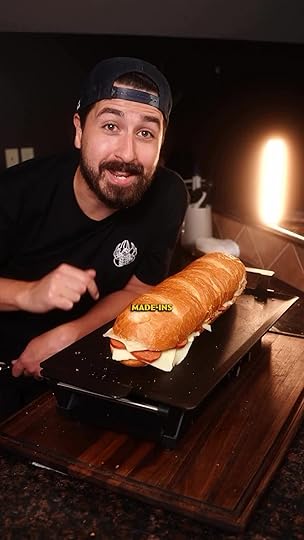
BEST: Brown Butter Maple Blondies
WORST: Ice Cream in Tofu
The post September 20, 2024: Recent Yes/No’s – Best and Worst! appeared first on Joseph Mallozzi's Weblog.
September 19, 2024
September 19, 2024: The Twilight Zone rewatch continues with season 3, episodes 29-32!
Season 3, Episode 29, “Four O’Clock”
This episode first aired April 6, 1962.
This episode was based on a short story by author Price Day that was originally published in the April 1958 issue of Alfred Hitchcock Mystery Magazine and, later, collected in the hardcover anthology “Alfred Hitchcock Presents: My Favorites in Suspense”. The latter was sent to the production offices by Random House who were pitching Rod Serling on a similar Twilight Zone-themed collection. While perusing the anthology, Serling took a shine to Day’s story and had the production make him an offer on the television rights.
Actor Theodore Bikel, who played Oliver Crangle, built a career playing villains onscreen. He received an Academy Award nomination for his performance in The Defiant Ones (1958) and received two Tony nominations for his work on Broadway. Bikel helped created the role of Captain Von Trapp as part of the original Broadway cast of “The Sound of Music”. Rodgers and Hammerstein wrote the song “Edelweiss” specifically for him to perform.
Reflecting back on his Twilight Zone experience, Bikel stated: “As you may rightly assume, my portrayal of Oliver Crangle stayed in my memory much longer than the many parts I have played on TV and elsewhere. It was a superbly written episode and a wonderful character to get my teeth into. Crangle was, of course, politically the very opposite of where my own convictions lie, then and now. To portray a ring wing nut gave me a great pleasure.”
Moyna MacGill, who played Mrs. Williams, was the mother of Angela Lansbury.
Serling’s ability to deliver message episodes ranges from accomplished to bungled and this clunker falls in the latter category. Lots of talk-talk as Crangle plots to shrink his victims down in size, presumably so that they’ll be easier to identify. How, exactly, does he plan to do this remains a mystery. The ending is predictable, but could have been saved if he had been eaten by his parrot but, alas, we didn’t even get that.
Season 3, Episode 30, “Hocus Pocus and Frisby”
This episode first aired April 13, 1962.
This episode was based on an idea by Frederic Louis Fox who also provided the idea for “Showdown with Rance McGrew”. In the original pitch, the main character, Henry Tibbs, is a spinner of tall tales whose outlandish lies are picked up on alien radio. He is offered the opportunity to travel to Mars to pick up residuals owed him but chooses instead to take a around trip around the world via flying saucer. When he returns home, he discovers that, while away, he was awarded first price in the Burlington Liars Contest. Realizing no one will believe his story, he simply doesn’t tell them about his alien encounter. After receiving the story proposal, Rod Serling wrote back: “Mr. Tibbs is a delight. If we go back into production for ten more films, I’ll have one of our people contact your agent. Hang on and don’t lose the faith.”
The flying saucer featured in this episode was from Forbidden Planet (1956). The ship’s inner console, also from the same movie, was reused in The Man from U.N.C.L.E. (1964) and was previously seen in season 1’s “Third From the Sun”.
Actor Andy Devine, who played Somerset Frisby, was a comic actor who owed his career to his trademark raspy voice, the result of a childhood incident that purportedly involved him tripping and falling and having a curtain rod rammed through the roof of his mouth. He co-starred as Jingles P. Jones opposite Guy Madison in Adventures of Wild Bill Hickok (1951) and later hosted the children’s show Andy’s Gang (1955).
Howard McNear, who played Mitchell, portrayed Lloyd the Barber on The Andy Griffith Show (1960). After suffering a stroke that made it difficult for him to use his arms and legs, he returned to the show where the production continued to feature him in close-ups or scenes in which his character was seated. According to fellow actor Don Knotts, McNear was not that different from the colorful character he played on the show.
Dabbs Greer, who played Scanlan, was Reverend Alden on Little House on the Prairie (1974). He was also a series regular on Gunsmoke (1955), Hank (1965), and Picket Fences (1992). His final appearance was in the The Green Mile.
So why exactly was this episode called Hocus Pocus and Frisby? Hocus Pocus suggests magic, yet there was no spellcasting to be had. While I thought Andy Devine terrific and the comedic elements not egregiously cringey, my main gripe with the episode is the rather convenient method by which Frisby escapes his captors. The harmonica felt like a contrived, quick-fix solution to his problem.
All in all, I found this one just so-so.
Season 3, Episode 31, “The Trade-Ins”
This episode first aired April 20, 1962.
This episode was inspired by O’Henry’s 1905 short story “The Gift of the Magi”.
Joseph Schildkraut, who played John Holt in this episode, previously appeared as Alfred Becker in “Deaths-Head Revisited”. His second wife of twenty-nine years passed away during filming but, rather than disrupt production, he insisted on completing work on the final two days.
According to Schildkraut: “I know this might have been mentioned briefly, but to get the reaction on my face when I looked at Alma Platt and realized she was hurting inside, the director wanted to shut off the sound in the studio and then shoot a gun in the background so my look of shock and surprise is real.” Kind of silly, but I’ve been on productions where directors have resorted to cheap tricks like this to get a “better” performance for their actors.
Ted Marcuse, who played Farraday, appeared as Citizen Gregori in “To Serve Man”.
The elderly couple trading in their old bodies for new reminded me of John Scalzi’s Old Man’s War which hinges on a very similar technology. I wonder if he drew inspiration from this episode? It’s a great idea.
I loved the poker scene where Farraday shows sympathy for Holt by allowing him to win that final hand. I did not, however, buy the ending. Didn’t buy that Holt would excitedly tell his wife all of the amazing things they would be able to do given the fact she was still elderly. Didn’t buy his wife’s over-the-top horrified reaction to what he was saying (which was, apparently, supposed to be quite subtle). Didn’t buy his decision to switch back to his original body when he could have just shut up about the holiday plans and got to work earning money for her procedure. Didn’t buy his “A little pain is worth it” excuse when, the scene earlier, the pain was so bad he felt he had no choice but to undergo the procedure. Didn’t buy the “happy ending” given that, in reality, it would be a shortlived, pain-ridden conclusion that could well have been avoided. Did not love.
Season 3, Episode 32, “The Gift”
This episode first aired April 27, 1962.
“The Gift” was originally written as the possible series pilot but the wise decision was made to go with “Where is Everybody?”. Not to be dissuaded, Rod Serling pitched the idea of doing a Twilight Zone movie back in the 60’s and rewrote the script for this episode into a feature screenplay – that ultimate, thankfully, went nowhere.
This episode was previously titled “The Guest” and then “The Visitor”.
This episode, with its clearly religious overtones, aired the week after Easter.
Actor Geoffrey Horne, who played Williams, lost out on the lead role in Ben Hur to Charlton Heston.
Nico Minardos, who played the doctor, reflected back on this episode: “I did some thirty movies over the years and a number of television and of all of those, The Twilight Zone is the one I get more mail about. I’m getting fan mail from Switzerlaned, Ireland, Germany, as well as the United States. In those years we used to rehearse a couple days, and then film for three days. Rod wanted me to do the show and what I remember most was the exctiement we all had of the show We knew it was an allegory to Jesus Christ, which was the premise, and everyone was trying to remain calm for the crowd sequence.”
In 1966, while shooting a scene on the Huallaga River in Peru for a TV movie called “High Jungle”, the canoe Minardos and fellow actor Eric Fleming were in tipped over. Minardos managed to swim back to shore, but Fleming drowned.
In 1986, Minardos was indicted on charges of conspiracy to illegally ship arms to Iran. The indictment was eventually tossed, but the charges nevertheless forced him into bankruptcy and ended his career.
Henry Corden, who played Sanchez, was the second voice of Fred Flinstone, replacing the iconic Alan Reed after he passed.
Vitto Scotti, who played Rudolfo, was last seen in “Mr. Bevis” as a street peddler with a monkey.
Well, here we are. The most boring episode of The Twilight Zone capped with a Christian allegory that doesn’t so much hit you over the head as it punches you repeatedly in the face. Throw in some embarrassingly wooden performances and a smattering of atrocious Mexican accents, and you have the recipe for what is, without a doubt, one of this show’s very worst entries.
The post September 19, 2024: The Twilight Zone rewatch continues with season 3, episodes 29-32! appeared first on Joseph Mallozzi's Weblog.
Joseph Mallozzi's Blog
- Joseph Mallozzi's profile
- 39 followers


